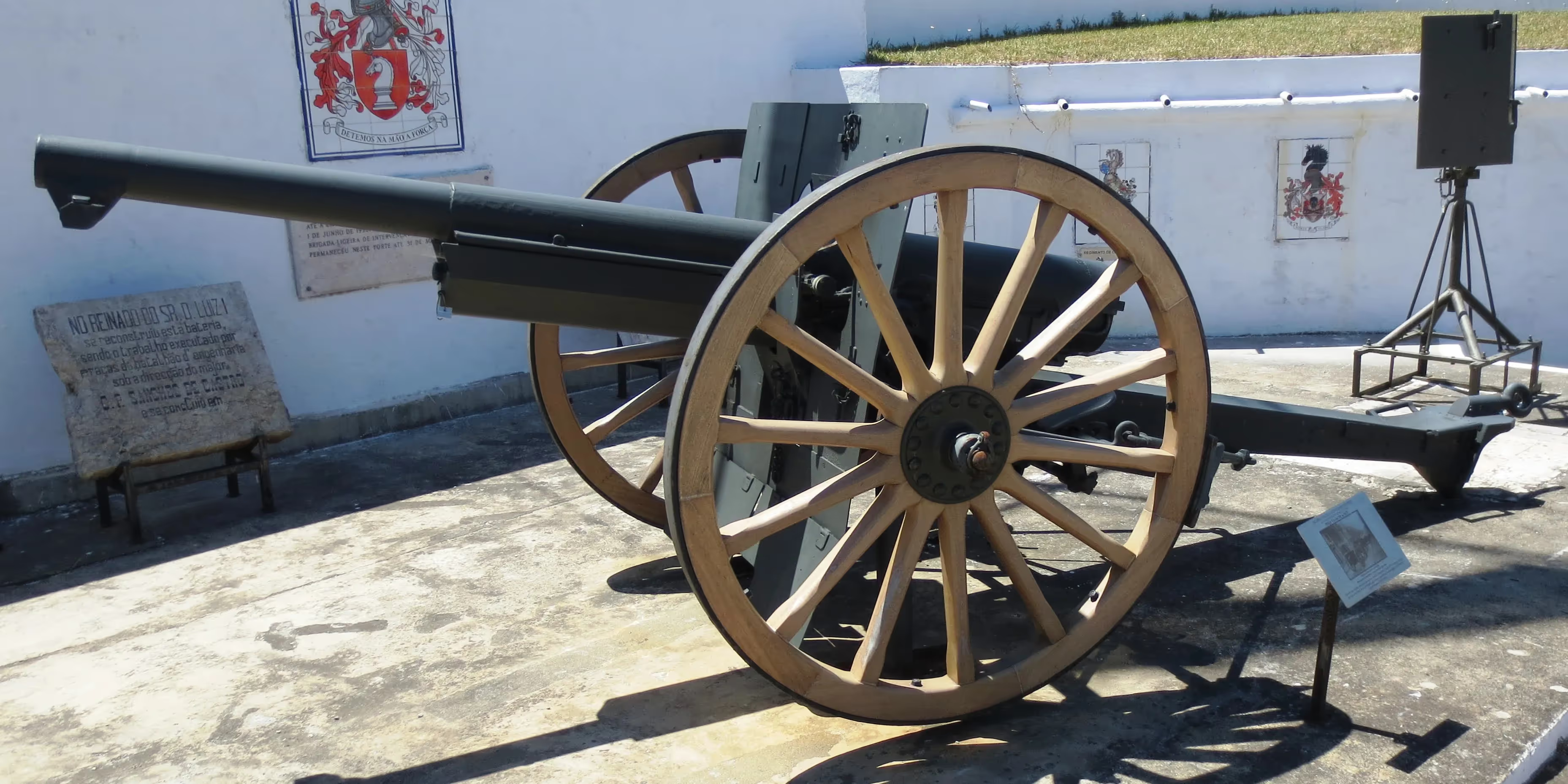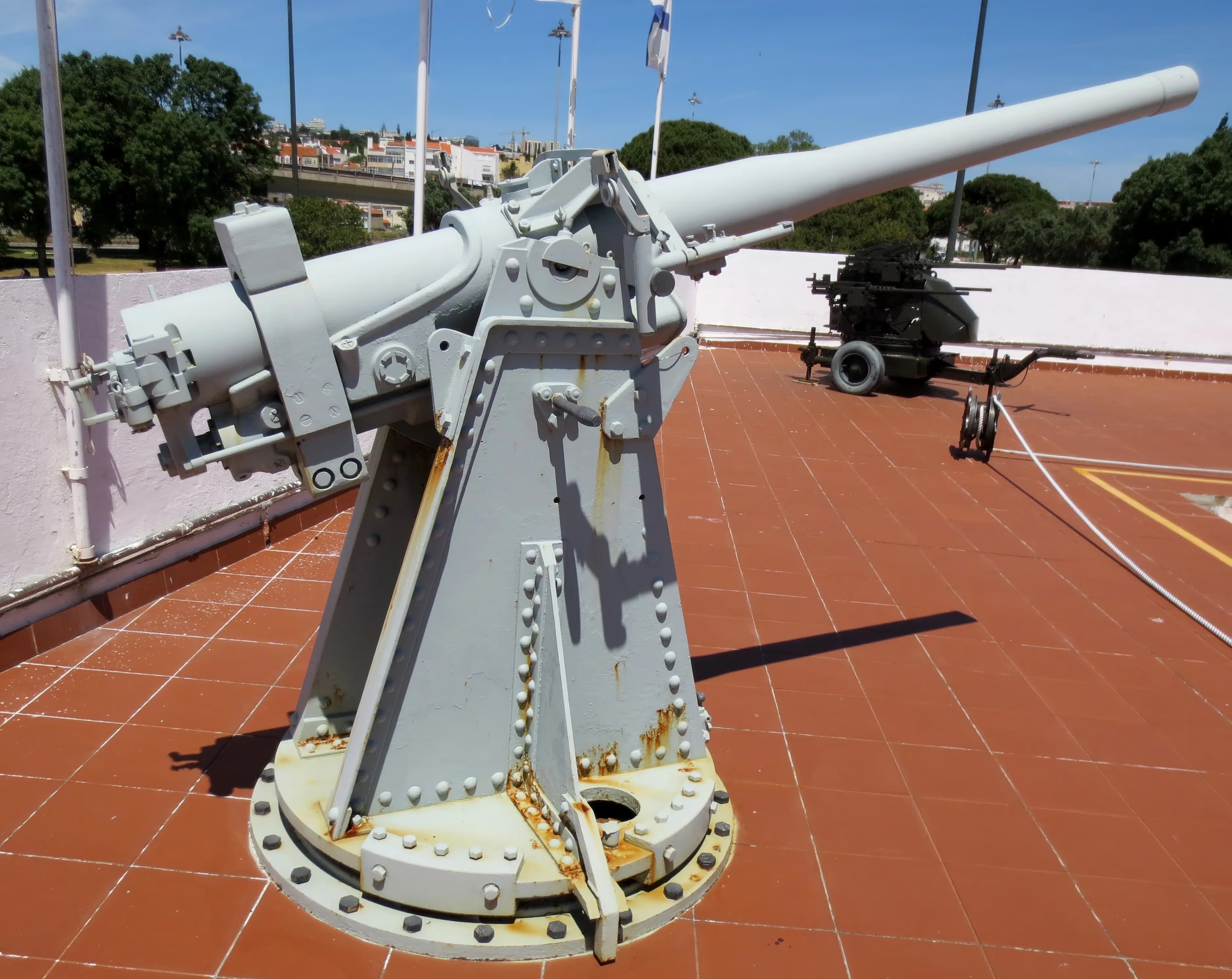Artillery in Portugal: Lisbon, Fort do Bom Sucesso, Museu do Combatente
Artillery in Portugal (Part 4)
Fort of Good Success, Combatant Museum
Lisbon
The aim of this website is to locate, identify and document every historical piece of artillery preserved in Portugal. Many contributors have assisted in the hunt for these guns to provide and update the data found on these web pages. Photos are by the author unless otherwise credited. Any errors found here are by the author, and any additions, corrections or amendments to this list of Guns and Artillery in Portugal would be most welcome and may be e-mailed to the author at [email protected].
Artilharia em Portugal (Parte 4)
Fort do Bom Sucesso, Museu do Combatente, Lisbon
O objetivo deste site é localizar, identificar e documentar cada peça histórica de artilharia preservada em Portugal. Muitos
colaboradores ajudaram na busca por essas armas para fornecer e atualizar os dados encontrados nessas páginas da web. As fotos são do autor, salvo indicação em contrário. Qualquer erro encontrado aqui é do autor e quaisquer acréscimos, correções ou alterações a esta lista de armas e artilharia em Portugal serão bem-vindos e podem ser enviados por e-mail ao autor em [email protected].
Fort do Bom Sucesso, Museu do Combatente Artifacts, Lisbon, Portugal
The Fort do Bom Sucesso (Fort of Good Success) dates back to the late eighteenth century. It was built to protect Lisbon’s seaward approaches and its main defensive gun batteries still point out towards the mouth of the Tagus estuary. The fort is now used to house the Museu do Combatente (Museum of Combatants), run by the League of Combatants. The museum tells the story of Portuguese military personnel serving in the Guerra do Ultramar (Overseas War/Portuguese Colonial War) fought from 1961 to 1975 in Angola, Guinea-Bissau and Mozambique. The museum holds a considerable collection of artillery much of which is on display outdoors, as well as a Stuart tank and a wheeled APC. Inside are numerous smaller exhibits of small arms, uniforms and memorabilia which have been part of Portugal’s military history.


Bronze Smoothbore Muzzleloading Mortar, unmounted.


Smoothbore Muzzleloading Mortar with dolphin carrying handles, unmounted.






Bronze Smoothbore Muzzleloading Guns, very highly decorated pair with Portuguese coat of arms.


(manchanegra Photos)

Cast Iron possibly 48-pounder Smoothbore Muzzleloading Gun, SG on the right trunnion, unmounted.

Cast Iron Smoothbore Muzzleloading Gun, heavily corroded.

Cast Iron Smoothbore Muzzleloading Gun, heavily corroded.

(manchanegra Photo)


(Author Photos)
Blomefield Cast Iron possibly 18-pounder Smoothbore Muzzleloading Gun, weight 40-0-1 (449 lbs) below the Portuguese coat of arms cypher, Serial No. 57 on the right trunnion.

Blomefield Cast Iron possibly 18-pounder Smoothbore Muzzleloading Gun, heavily corroded.



Cast Iron Smoothbore Muzzleloading Naval Gun, 18th Century on display near the Tagus beside the Museum. This gun was cast in the Lavache Foundry in Foz do Alge. Lavache was a French gun factory established in Portugal in the 1700´s, casting a number of guns for the Portuguese Navy. The Portuguese coat of arms are on the top of the gun and it is stamped "Lavache" and the date 1757.



Spanish Smoothbore Muzzleloading Gun, Trubia 1861, No. 675, P.o 4072 Ks on the trunnion. This gun was cast in the Spanish Factory of Trubia in the Asturias in 1861.


Peca BEM 7-cm m/882 Mountain Gun.



7.5-cm Schneider-Canet Model 1917 Field Gun.


Soviet Degtyarev 12.7-mm machine-gun.



Soviet Degtayrev 12.7-mm machine-gun with shield.


60-mm M-2 m/52 Light Infantry Mortar.


Medium Mortar, Hadfields (Newton Mortar).



120-mm Soltam M-65 mortar. This mortar was developed by Tampella in 1953 via introduction of new baseplate for the 120-mm Krh/40 mortar invented by Hans Otto Donner. In the 1960s Soltam Systems of Israel bought a license. The mortar system comes in two versions, a standard mortar and a long-range version. This heavy mortar is light enough to be transported by a helicopter in a sling load, dropped by parachute or carried in an APC such as the M113 Armored Personnel Carrier. It can also be towed as a normal artillery piece or manhandled if necessary. The wheels on the carriage are the same as fitted to the M151 Jeep, and have handling rings to aid in manhandling it. All components are made of chrome-plated or stainless steel to resist wear and corrosion. The M-65 is the standard version of this mortar, while the A-7 is the long-range version.




20-mm Oerlikon Anti-aircraft Machine-gun Mk. II, (Serial No. S28056).



German 150-mm Krupp Naval Gun (Serial Nr. 12), 1899, on a Naval mounting. This gun fired a 44.2 kg shell to a range of 18,700 metres.



QF 12-pounder 12-cwt Naval Gun (Serial No. 11107), CPP 1943. The QF 12 pounder 12 cwt gun was a versatile 3-inch (76-mm) calibre naval gun introduced in 1894 and used until the middle of the 20th century. It was produced by Armstrong Whitworth, Elswick in England for use on warships, and exported to allied countries. In British service, "12 pounder" was a rounded reference to the projectile weight and "12 cwt" referred to the weight of the barrel and breech: 12 hundredweight = 12 X 112 pounds = 1,344 pounds, to differentiate it from other 12-pounder guns.



Naval Gun, TFS, 101, MARCA MA, 1952.



M55 Quadmount .50 caliber towed Anti-aircraft gun system. The M55 is a weapon mounting consisting of four of the "HB", or "heavy barrel" .50 caliber M2 Browning machine guns (of the M2 Turret Type (TT) variant, mounted in pairs on each side of an open, electrically powered turret. Although designed as an anti-aircraft weapon, it was also used against ground targets during the Second World War.



Obice da 75/18 modello 35 Howitzers (3). The 75-mm Obice da 75/18 modello 34 with a box trail could be broken down into eight loads for transport (the modello 35 could not, but had a split trail). In the interest of standardization and logistics a version of the 75/18, the modello 35 was also used as the light howitzer component of normal field batteries. In 1940 large number of these guns were sold to Portugal. No. 1 of 3.

Obice da 75/18 modello 35 Howitzers (3). No. 2 of 3.



Obice da 75/18 modello 35 Howitzers (3). No. 3 of 3.




105-mm OTO Melara Mod 56 Light Gun.




Ordnance QF 6-pounder Anti-tank Gun.



M5A1 Stuart light tank,
Other military artifacts and weapons on display in this museum. During the 1960s and 1970s, Canada provided the Portuguese Army with used tanks as military aid.

German Sachs Hercules Military motorcycle, MX-32-72.

Portuguese Army rifle collection.

6.5-mm Madsen Model 1940 light machine-gun. This LMG was adopted by the Danish Army in 1902. It was one of the first true light machine guns produced in quantity and sold to over 34 different countries worldwide in 12 different calibres, seeing extensive combat use in various conflicts around the globe for over 100 years. During the Portuguese Colonial War of the 1960s and 1970s the Portuguese Army used Madsen machine guns. Madsens served as temporary armament for Auto-Metralhadora-Daimler 4 × 4 Mod.F/64 armoured cars, which were Daimler Dingos modified with the addition of a turret-like structure.

7.92-mm m/98 light machine-gun. This LMG is the Portuguese version of the German Maschinengewehr 13 (MG 13) general-purpose machine gun which was developed by rebuilding a First World War water-cooled machine gun. The MG 13 was introduced into service in Germany in 1930, where it served as the standard light machine gun. It was officially withdrawn from service in 1934; most of the MG 13s were sold to Portugal, where they were used into the late 1940s Metralhadora 7,92 mm m/938 Dreyse.

Vickers-Berthier (VB) light machine-gun.

The Breda Modello 37 was an Italian was a gas-operated, air-cooled heavy machine gun (Mitragliatrice Breda MOD.37) adopted in 1937. The M37 was meant as company/battalion support weapon. The weapon was fed by 20-round strips of cartridgesThe M37 was adopted by the Portuguese armed forces, who placed it into service as the Metralhadora pesada 7,92 mm m/938 Breda heavy machine gun. The Breda saw extensive service in Portugal's African colonies during the early stages of the Portuguese Colonial Wars.

Shoulder-mounted M20B1 Super Bazooka 3.5-inch anti-tank motor launcher.


Ford M151A2 Mutt (Jeep).


Fiat-Dornier G91R-4 (Serial No. 5420) Força Aerea Portuguesa fighter-ground attack aircraft, forward fuselage.

Fiat-Dornier G91R-4, Força Aerea Portuguesa, mounted on a display stand. (Photo courtesy of Soares da Silva)

Bravia Chaimite V-200 Armoured Personnel Carrier.
The Bravia Chaimite is an armoured vehicle with all wheel drive axles built by the Portuguese company Bravia and used by the Portuguese Army in the Portuguese colonial wars in Angola, Mozambique and Portuguese Guinea, from 1967 to 1974 when it ended. There were two versions of the Chaimite, the VBTP V-200 and the VBPM V-600. The VBTP, (Viatura Blindada de Transporte de Pessoal, Armoured Personnel Transport Vehicle), had an 11-man capacity and was armed with one .50-cal Browning heavy machine-gun, while the VBPM, (Viatura Blindada Porta-morteiro, Armoured Mortar Carrier Vehicle), had only a 4-man capacity and was armed with one Browning .30-cal heavy machine-gun and one 81 mm mortar. These vehicles had diesel engines with 155 hp (115 kW) at 3300 rpm with automatic gear capable of taking on speeds to a maximum of 99 km/h (62 mph). The armour of this APC was capable of defeating rounds up to 7.62 mm NATO. The Chaimite is gradually being phased out of Portuguese Army service.





